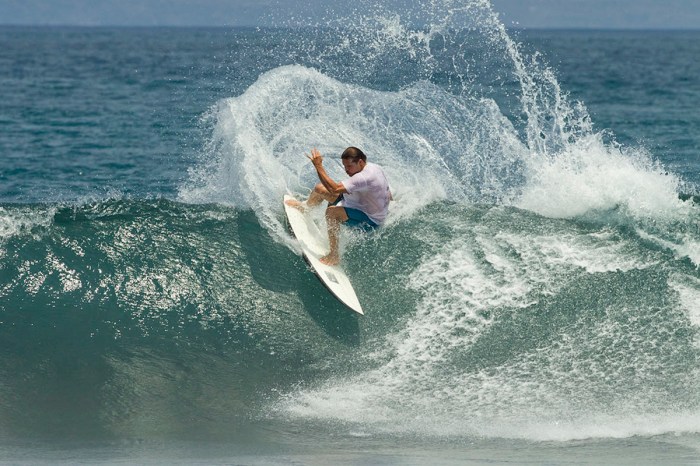Surfing Basics: Kicking off with the essentials of surfing, this overview dives into the thrilling world of catching waves and hanging ten. From choosing the right board to mastering the art of riding waves, get ready to ride the tide like a pro.
Whether you’re a newbie looking to hit the waves or a seasoned surfer brushing up on the fundamentals, this guide has got you covered from start to finish.
Surfing Basics Overview

Surfing is a thrilling water sport that involves riding waves on a surfboard. It has gained immense popularity worldwide due to its adrenaline-pumping action, connection to nature, and laid-back beach culture. Surfers of all skill levels, from beginners to professionals, are drawn to the ocean for the exhilarating experience of catching a wave and riding it to shore.
Essential Equipment for Surfing
When hitting the waves, surfers need to have the right gear to ensure a safe and enjoyable experience. The essential equipment for surfing includes:
- A surfboard: The most critical piece of equipment, available in various shapes and sizes to suit different skill levels and wave conditions.
- Leash: A cord that attaches the surfer’s ankle to the surfboard, preventing it from getting carried away by waves.
- Wetsuit: Provides insulation and protection from cold water, keeping surfers warm during extended sessions.
- Wax: Applied to the surfboard for traction, allowing surfers to maintain their grip while riding waves.
- Fins: Help stabilize the surfboard and control direction while riding waves, available in different configurations for various surfing styles.
Getting Started
When starting out in surfing, it’s crucial to choose the right surfboard for beginners. Selecting the appropriate surfing location and knowing how to paddle out and catch waves effectively are also key to a successful surfing experience.
Choosing the Right Surfboard for Beginners, Surfing basics
- Opt for a soft-top surfboard to prevent injuries while learning.
- Choose a longer and wider board for stability and easier paddling.
- Consider a foam board for better buoyancy and forgiveness when catching waves.
Selecting the Appropriate Surfing Location
- Start in smaller, less crowded waves to build confidence and skills.
- Avoid areas with rocky bottoms or strong currents, especially as a beginner.
- Look for beginner-friendly breaks with consistent waves and a sandy bottom.
Paddling Out and Catching Waves Effectively
- Paddle out through the white water by timing your movements with the waves.
- Position yourself properly on the board to optimize paddling efficiency.
- When catching a wave, paddle hard and pop up quickly to your feet for the best chance of riding it successfully.
Surfing Techniques

When it comes to mastering the art of surfing, understanding proper techniques is key. From the correct stance on the board to executing smooth turns while riding a wave, each aspect plays a crucial role in your surfing experience.
Proper Stance and Positioning
Maintaining the right stance and positioning on a surfboard is essential for balance and control. To achieve this, position yourself in the center of the board, with your feet shoulder-width apart. Keep your knees slightly bent and your weight centered to stay stable while riding the waves.
Popping Up from Paddling to Standing on the Board
The transition from paddling to standing on the board, known as “popping up,” is a fundamental skill in surfing. As you catch a wave, paddle until you feel the momentum propelling you forward. Then, place your hands flat on the board near your chest and push yourself up into a crouching position. Finally, smoothly extend your legs to stand up, keeping your weight centered for balance.
Turning and Maneuvering on the Wave
Once you’re up and riding the wave, the ability to turn and maneuver is crucial for navigating the water effectively. To turn on a wave, shift your weight towards the direction you want to go and use your body to guide the board. Practice leaning into turns and using your arms for balance to master the art of maneuvering while surfing.
Safety Precautions
Surfing can be an exhilarating experience, but it’s essential to prioritize safety while out on the waves. By being aware of common hazards, understanding surf etiquette, and knowing how to handle rip currents, you can ensure a safer surfing session.
Common Surfing Hazards and How to Avoid Them
- Avoid collisions: Always be aware of other surfers around you and maintain a safe distance to prevent accidents.
- Watch out for marine life: Be cautious of jellyfish, sharks, and other sea creatures that may pose a threat while surfing.
- Beware of strong currents: Rip currents and undertows can be dangerous, so familiarize yourself with the water conditions before entering.
Significance of Understanding Surf Etiquette
- Respect other surfers: Follow the rules of the lineup, take turns, and avoid dropping in on someone else’s wave.
- Communicate effectively: Use hand signals and verbal cues to alert others of your intentions while surfing.
- Keep the ocean clean: Dispose of trash properly and respect the environment to maintain the beauty of the ocean.
Tips for Dealing with Rip Currents
- Remain calm: Stay composed and conserve your energy if you find yourself caught in a rip current.
- Don’t fight the current: Instead of swimming against it, swim parallel to the shore to escape the rip current’s pull.
- Signal for help: Wave your arms and call out for assistance if you’re struggling to get back to shore.